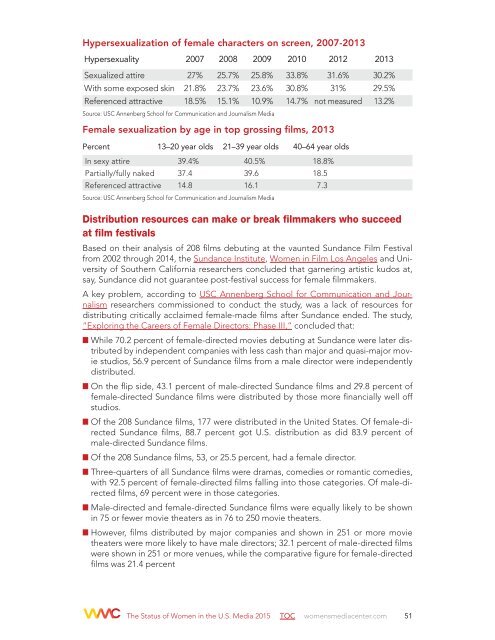THE STATUS OF WOMEN IN THE U.S MEDIA 2015
83bf6082a319460eb1_hsrm680x2
83bf6082a319460eb1_hsrm680x2
Create successful ePaper yourself
Turn your PDF publications into a flip-book with our unique Google optimized e-Paper software.
<strong>WOMEN</strong>’S <strong>MEDIA</strong> CENTER<br />
Hypersexualization of female characters on screen, 2007-2013<br />
Hypersexuality 2007 2008 2009 2010 2012 2013<br />
Sexualized attire 27% 25.7% 25.8% 33.8% 31.6% 30.2%<br />
With some exposed skin 21.8% 23.7% 23.6% 30.8% 31% 29.5%<br />
Referenced attractive 18.5% 15.1% 10.9% 14.7% not measured 13.2%<br />
Source: USC Annenberg School for Communication and Journalism Media<br />
Female sexualization by age in top grossing films, 2013<br />
Percent 13–20 year olds 21–39 year olds 40–64 year olds<br />
In sexy attire 39.4% 40.5% 18.8%<br />
Partially/fully naked 37.4 39.6 18.5<br />
Referenced attractive 14.8 16.1 7.3<br />
Source: USC Annenberg School for Communication and Journalism Media<br />
Distribution resources can make or break filmmakers who succeed<br />
at film festivals<br />
Based on their analysis of 208 films debuting at the vaunted Sundance Film Festival<br />
from 2002 through 2014, the Sundance Institute, Women in Film Los Angeles and University<br />
of Southern California researchers concluded that garnering artistic kudos at,<br />
say, Sundance did not guarantee post-festival success for female filmmakers.<br />
A key problem, according to USC Annenberg School for Communication and Journalism<br />
researchers commissioned to conduct the study, was a lack of resources for<br />
distributing critically acclaimed female-made films after Sundance ended. The study,<br />
“Exploring the Careers of Female Directors: Phase III,” concluded that:<br />
While 70.2 percent of female-directed movies debuting at Sundance were later distributed<br />
by independent companies with less cash than major and quasi-major movie<br />
studios, 56.9 percent of Sundance films from a male director were independently<br />
distributed.<br />
On the flip side, 43.1 percent of male-directed Sundance films and 29.8 percent of<br />
female-directed Sundance films were distributed by those more financially well off<br />
studios.<br />
Of the 208 Sundance films, 177 were distributed in the United States. Of female-directed<br />
Sundance films, 88.7 percent got U.S. distribution as did 83.9 percent of<br />
male-directed Sundance films.<br />
Of the 208 Sundance films, 53, or 25.5 percent, had a female director.<br />
Three-quarters of all Sundance films were dramas, comedies or romantic comedies,<br />
with 92.5 percent of female-directed films falling into those categories. Of male-directed<br />
films, 69 percent were in those categories.<br />
Male-directed and female-directed Sundance films were equally likely to be shown<br />
in 75 or fewer movie theaters as in 76 to 250 movie theaters.<br />
However, films distributed by major companies and shown in 251 or more movie<br />
theaters were more likely to have male directors; 32.1 percent of male-directed films<br />
were shown in 251 or more venues, while the comparative figure for female-directed<br />
films was 21.4 percent<br />
The Status of Women in the U.S. Media <strong>2015</strong> TOC womensmediacenter.com 51


